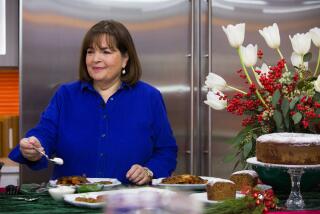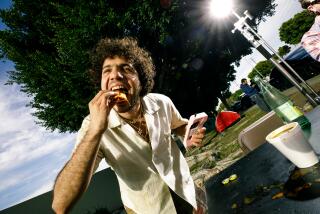How to Tan a Chicken--and Other First-Time Cooking Adventures
My friend Marcia often jokes that she does so little cooking she uses her stove as a planter. âBut then,â she almost always continues, âI know someone who took the stove out of her kitchen altogether.â
OK, I confess. She was talking about me. My feelingâs always been that if God had wanted us to cook, He wouldnât have created take-out.
But no longer. I have joined the ranks of the cooking. I still havenât put the stove back in, but Iâm actually preparing my own meals from scratch. Simple, yes. Boring, maybe. But definitely home-cooked meals low in fat, salt, cholesterol and calories.
I wish I could say I did this willingly. Rather, I was forced into it kicking and screaming because of a health problem. And there are still many moments, measuring cup in hand, that Iâm sure the person in my kitchen has got to be my evil twin. This, then, is the story of âHow I Learned to Cook.â
Itâs ridiculous, isnât it? A grown woman not knowing how to cook? I mean, everyone knows how, right? Wrong. I come from a long line of non-cooks, darn proud of it.
But donât misunderstand. I know a thing or two about food. I can go into the best restaurant, order a fabulous dinner and detect almost every ingredient used. I just donât know how to combine those ingredients in my own kitchen and have them come out looking even remotely like a meal.
Cookbooks arenât much help. Everything in Martha Stewartâs book looked as if it had been prepared in a Stepford Wifeâs kitchen. And that was her easy-to-make edition!
Not only are cookbooks intimidating to the non-cook, theyâre about as easy to understand as a computer manual. OK, browning is self-explanatory. But what about sauteing? You canât imagine the agony I went through figuring that one out.
Or a baked potato. Do I cook them wet or dry? Naked or wrapped in foil? I once had one blow up in my oven, apparently because I didnât know to make some holes in it ahead of time.
Ah yes, my past culinary disasters are legion. Those TV cooking shows arenât much help either.
What little I know about cooking comes mostly from the movies. After all, I did see âBabetteâs Feastâ and âMy Dinner with Andre.â But that scene from Steven Spielbergâs âAlwaysâ where Holly Hunter buys a meal from a restaurant, rushes it into her kitchen and pretends she made it herself really hit closer to home.
Then, in January, I was diagnosed with diabetes. At a meeting with the nutritionist at St. Johnâs Hospital, I suddenly realized with horror that I was going to have to cook for myself for the foreseeable future. Because in order to manage my disease with insulin, I needed to watch everything I put into my mouth. And that meant knowing exactly how the food I ate was prepared.
Diabetics often are the healthiest eaters on the planet. To control blood glucose levels, I had to eliminate sugar and also eat the right combinations of food. The object was to get more than half of my daily calories from carbohydrates, and to cut down on fat and protein.
The nutritionist told me I had to eat three meals a day, plus a snack before bedtime, which seemed to call for an enormous amount of cooking. She worked up 1,500-calorie-a-day meal plans culled from six so-called âexchange listsâ: starch/bread, meat and substitutes, vegetables, fruit, milk and fat. A friend whoâs a perennial dieter looked them over and declared they were almost identical to Weight Watcherâs.
Thus armed, I threw out everything in my refrigerator (an open bottle of Champagne) and everything in my cupboards (one can of foie gras from a trip to France) and started all over.
It used to take me three minutes to zip through a grocery store--some lemons for tea, a bag of fruit and maybe some frozen dinners. After my hospitalization, Iâd spend three hours at Gelsonâs.
My friend Judy introduced me to the art of reading labels. This was an alien world to me, but soon I learned that one oil is better than another (and Pam is best), that nonfat milk, cottage cheese and yogurt really save on calories, and that sugar and salt are hidden dangers lurking inside the most innocuous foods. Even now, though Iâve got things a little more under control, I still need an hour to go through the store.
Next, I had to look at the meager equipment I had in my kitchen. To supplement my microwave and toaster ovens, I bought a hot plate and an electric wok. (Sorry, but the stove is still out; it would make my kitchen look cramped.)
The wok took some getting used to. The first time I used it, I needed two friends to keep me company and keep up my courage.
I was convinced disaster was just around the corner--that it would burn up, blow up or worse. The actual experience of cooking in it was rather anticlimactic. All it did was spit a few times.
To ensure I ate the right amounts of food allowed in my meal plans, I bought a food scale as well as my first measuring cups and spoons. Lastly, I bought some spices and a rack in which to hold them. Spices, I believe, are the secret to low-calorie cooking. (I know, I know, it sounds like Iâm reinventing the wheel.)
Now, the moment of truth had arrived--to actually start cooking. That first meal was the hardest. I wanted to cook a Cornish game hen Iâd bought fresh. But how?
I stared at the bird for about an hour, hoping it would start speaking and give me pointers. I looked forlornly at my spices, but I didnât know which ones were meant for poultry. So I got on the phone and called everyone I knew. âRoast it,â they all suggested.
I took a high-sided pot out of the cupboard, which I guessed to be a roasting pan, and plopped the bird in it. Oops, I forgot to wash it. I scrubbed and scrubbed until the poor bird looked battered.
Then I tore off the skin because I wasnât allowed to eat it. Naked and sad-looking, I thought the hen needed some color. You know, a tan. I took something red--paprika, it turned out--and shook it all over. Then, I drowned the bird in garlic powder, onion flakes and black pepper.
I wasnât sure what else to do, so I looked inside my refrigerator. Hmmm , those fresh mushrooms might be good with it. (Later, I discovered that fresh mushrooms make everything taste better--both cooked and raw.) So I tossed a dozen into the pan and, as an afterthought, added an inch of water to make sure they wouldnât burn.
In fact, I tend to char food because of a lack of concentration while I cook. This tendency to zone-out was one of the things that scared me away from cooking in the first place. Nowadays, however, if I burn something I just throw it out and try again. I refuse to get upset about a ruined $3.06 piece of poultry.
Not having a clue about what I was doing, I put the hen into the toaster oven and set it at 250 degrees. Then I remembered that wonderful scene from the movie âThe Accidental Tourist,â the one where the eccentric family refused to eat their sisterâs Thanksgiving turkey because it had cooked at too low a heat to kill the germs. So I raised the temperature to 400 degrees and hoped for the best.
I got it. The hen was fabulous!
The water and mushrooms had combined with the drippings from the hen to create a lovely low-calorie sauce, which I spooned over cooked brown rice and paired with vegetables. By the way, rice is nice because itâs pretty foolproof. Basically itâs just equal parts water and rice--that is, if you use Minute Rice, which is perfectly edible.
What I like best about this meal is that itâs impossible to ruin. And, on my particular diet, one plumpish Cornish hen is good for three meals for one person, so I can pop it into the refrigerator and then heat it up anytime I want.
Thatâs what I find is the thing I like least about cooking. It seems that as soon as you prepare one meal, eat it and clean up, itâs time to start another. In those first few weeks, I felt like a hamster running the same maze day after day just to get to the cheese. Iâve now gotten into the habit of cooking enough at one time to last for several meals.
Another surprise is how much quicker, cheaper and better a home-cooked meal can be when compared to a frozen dinner or fast-food with an equivalent number of calories. After eating those ready-made meals for years, I figured that you canât expect 300 calories to taste like anything other than cardboard. Not so!
My turkey tacos, for instance, are not only mistake-proof and fast to prepare, they actually taste good. And, compared to commercially prepared tacos, theyâre very low in calories. I spray a small frying pan with olive oil-flavored Pam, add four ounces of ground white-meat turkey and stir on high heat until the pink color turns white.
Then I dump in a packet of Lawryâs taco seasoning (it contains no MSG) plus a half cup of water, turn down the heat and cover. Simultaneously, in my toaster oven, I brown several small corn taco shells. When I put the taco together, I add a little fresh salsa (make sure it doesnât contain oil) mixed with nonfat yogurt.
Two tacos plus a mixed green salad with diet dressing (I like Bernsteinâs best, but Healthy Sensationâs not bad) is a terrific meal that can be on the table in as few as 10 minutes.
Another quick trick is taking a chicken breast, or half a Cornish hen, plunging it into marinade and then throwing it on the barbecue. The problem is a lot of marinades involve oils, sugars or both. Two that donât are Jamaican jerk-style marinade (mild or spicy) or Chinese-style chile puree with garlic. I dilute both with lots and lots of lemon juice and then drown my poultry.
Meanwhile, after a few weeks of trial and error, I started looking for appropriate cookbooks. The best Iâve found for my dietary requirements are Jane Brodyâs âGood Food Bookâ and âGood Food Gourmet,â which stress high-carb, low-fat recipes and are surprisingly readable. Brodyâs âGood Food Bookâ also contains page after page of how-to instructions for the cooking novice on just about everything.
After a couple of false starts, I learned not just how to steam vegetables (buy one of those stainless-steel thingamabobs or do it in the wok), but how to steam them in chicken broth to add flavor but almost no calories (that is, if you use Pritikin broth).
Reading Brody, I also realized that âgood carbohydratesâ are more than just potatoes. In addition to the different kinds of rice and pasta in my cupboards, I now have something called cracked wheat bulgur because Brody says it goes well with chicken.
Her books have also got me cooking, among other things, turkey loaves, potato-salmon croquettes, broiled fish fillets with mustard, tomato-crowned halibut, and vegetable lasagna made with nonfat cheeses. But the single most important thing she has to say, in my opinion, is that meat, fish or chicken should rarely be served as an intact chunk of food.
Rather, she exhorts you to âslice it, sliver it, cube it, chop it or grind it, and combine it with lots of vegetables and a starchy food in a soup, stew, stir-fry or casserole.â
Thatâs why one of her recipes, stir-fried pork with green beans, is my all-time favorite. Itâs simple and allows for creativity. Iâve actually altered it to make it lower in fat and sodium than she does. Itâs my philosophy (yes, I now have a philosophy on cooking) that wok stir-frying doesnât have to be done with oil when a single tablespoon can be 120 calories or so. The same taste can be had with Pam and chicken broth.
Take a half-pound of lean boneless pork (or skinned chicken breast), trim off all the fat and cut it into thin strips. Throw the meat into a container and mix it with one tablespoon cornstarch, two tablespoons low-sodium soy sauce and one-half teaspoon dry mustard. This all combines to form a sort of marinade, which you set aside.
Cut one-half pound of fresh green beans (or fresh asparagus), into two-inch lengths. Also cut two dozen fresh mushrooms into coarse slices. Open a can of bamboo shoots (or water chestnuts) and rinse in cold water (to get any salt solution off them).
When everythingâs ready to go, spray the wok with Pam, heat it to 300 degrees and stir-fry the pork. Remove it and set aside. Do not clean the wok. Pour in half a can of Pritikin chicken broth and add the green beans and mushrooms. Add Chinese red pepper seasonings and one tablespoon of Sichuan spicy stir-fry sauce (House of Tsangâs is excellent). Simmer this on low heat.
When the green beans are tender, add the bamboo shoots and the pork. Simmer everything a little longer. Serve the whole thing with one cup of white or brown steamed rice. This quantity of stir-fry is enough for three separate meals and can be refrigerated and then reheated in the microwave without turning soggy.
Of course I realize that Iâm never going to become Julia Child. Once, I watched her make a Buche de Noel, complete with fake moss and mushrooms, and I thought Iâd never stop laughing because it seemed like so much wasted effort. I mean, wouldnât most families rather have a cake from Baskin-Robbins?
All I want to do, really, is come to terms with cooking.
And maybe, just maybe, Iâll dust off that stove and bring it back into the house. Itâd make a wonderful conversation piece in the hallway.
More to Read
Eat your way across L.A.
Get our weekly Tasting Notes newsletter for reviews, news and more.
You may occasionally receive promotional content from the Los Angeles Times.









